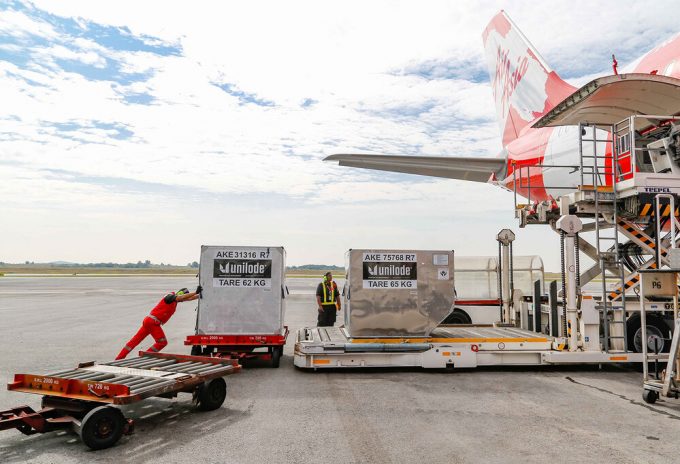Former Polar Air US customer service chief Schirmer jailed for fraud
Polar Air Cargo’s former senior director of customer service for the Americas, Robert Schirmer, has ...
FDX: ABOUT USPS PRIVATISATIONFDX: CCO VIEWFDX: LOWER GUIDANCE FDX: DISRUPTING AIR FREIGHTFDX: FOCUS ON KEY VERTICALFDX: LTL OUTLOOKGXO: NEW LOW LINE: NEW LOW FDX: INDUSTRIAL WOESFDX: HEALTH CHECKFDX: TRADING UPDATEWMT: GREEN WOESFDX: FREIGHT BREAK-UPFDX: WAITING FOR THE SPINHON: BREAK-UP ALLUREDSV: BREACHING SUPPORTVW: BOLT-ON DEALAMZN: TOP PICK
FDX: ABOUT USPS PRIVATISATIONFDX: CCO VIEWFDX: LOWER GUIDANCE FDX: DISRUPTING AIR FREIGHTFDX: FOCUS ON KEY VERTICALFDX: LTL OUTLOOKGXO: NEW LOW LINE: NEW LOW FDX: INDUSTRIAL WOESFDX: HEALTH CHECKFDX: TRADING UPDATEWMT: GREEN WOESFDX: FREIGHT BREAK-UPFDX: WAITING FOR THE SPINHON: BREAK-UP ALLUREDSV: BREACHING SUPPORTVW: BOLT-ON DEALAMZN: TOP PICK

Teleport claims its multimodel fleet strategy is redefining the interline process for the logistics market.
The South-east Asian logistics specialist says relying on a single-fleet model just won’t cut it any more, an integrated, hybrid model is the way forward, and has a hybrid cargo fleet of three A321-200Fs, access to Air Asia’s belly capacity and around 40 third-party partner airlines.
“This mixed fleet model enables us to move a diverse range of cargo to 85 cities throughout South-east Asia,” Jagedeswaran Nadrajah, head of air partners told The Loadstar. This accounts for 80% of the region’s network, including secondary and tertiary cities, he noted.
Listen to this clip from The Loadstar Podcast to hear host Mike King speaking to Loadstar Publisher Alex Lennane about IATA’s CASS fail:
In 2023, Teleport moved nearly 200,000 tonnes of cargo and 30 million parcels on a network that extends beyond the region, through partnerships, to markets in Asia Pacific, the Middle East, Oceania and Europe.
“Our growth strategy to further strengthen our network and operations is anchored on maximising capacity that is already available – and not just our own but also other airlines’,” said Mr Nadrajah.
“We are able to mutually grow our respective reach and capacity by air, as well as our capacity utilisation rate (including belly), thus ensuring we never fly empty, together.”
According to aviation advisory firm IBA, demand and capacity in the air cargo market is on the rise this year. This increase is set to be outstripped by an 8% rise in air cargo capacity, reaching 600.3 billion cargo tonne km. Consequently, cargo load factors are expected to continue their decline, from a pandemic peak of 56% in 2021 to a forecasted 43% this year.
“In Asia, that demand is being boosted through a rise in e-commerce volumes out of China flowing into South-east Asia,” said Mr Nadrajah. “We expect to see a continuation of this trend, in tandem with rising consumer demand for fast and cheap goods.”
Even with returning belly capacity, Nadrajah reckons the current utilisation of belly capacity in the region remains low, which presents a key opportunity to unlock existing capacity.
So, Teleport is banking on its airline partnership programme to leverage its regional presence with airline partners that have long-haul and complementary networks. He adds: “This allows us to focus on building partnerships that go beyond simple standby availability, or blocking space, while effectively repurposing the capacity that already exists without adding more.”
Teleport’s mixed fleet capacity using freighters and belly space works well with e-commerce demands, Mr Nadrajah noted. He believes this mix caters to the specific demands of e-commerce, such as small parcels, which can then be distributed to destinations beyond the primary network.
“This gives e-commerce platforms and businesses the opportunity for greater economic reach,” he added.
Media reports suggest the long-term plan is to gain around 30% of the $3bn e-commerce market in South-east Asia, and there are suggestions that Teleport is looking to increase its freighter fleet from three to ten by next year.
Also, an IPO might follow soon afterwards – however, any details of that remain sketchy.
Listen to the recent News in Brief Podcast for a quick refresher of last-week’s supply-chain news and insight into what might come up this week:
Comment on this article